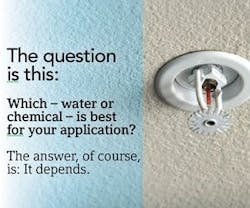Chemical- vs. Water-Based Suppression
Gaseous fire-suppression systems are most often associated with high-value/high-tech applications, based on the impression that water and electronic equipment don’t mix. In the 1980s, the “clean” agent Halon 1301 was king of fire suppression for these applications. With the advent of the Montreal Protocol concerning ozone depletion, the Halon 1301 commercial market collapsed almost overnight.
While manufacturers scrambled to find a replacement agent, loss-prevention managers were forced to find alternatives. Because of their water concerns, many managers chose pre-action sprinkler systems. A typical pre-action system requires the activation of the fire-alarm system before water is allowed to enter the pipe. This would prevent accidently knocking a sprinkler and causing massive water damage.
The pre-action system became so popular that, when replacement gases came to market, they didn’t capture back the Halon 1301 market share. Many high-value/high-tech facilities managers continue to install pre-action systems.
So, the question is this: Which is best for your application? The answer, of course, is: It depends. Experience has shown that, often, this decision is based on issues not directly related to fire concerns. Water damage is one example. Gaseous agents potentially provide a level of protection that sprinklers can’t, and vice versa. The goal of gaseous agents is to extinguish a fire in the incipient stages, thus giving a level of protection to the equipment within the area of origin; however, it’s a onetime application that, if it fails, could result in the loss of the building. The goal of sprinklers is to protect the building, thus affording less protection to the equipment.
Halon 1301 replacement agents fall into two categories: halocarbon agents and inert gases. While there are pros to using either of these agents or pre-action sprinklers, the cons often weigh more heavily in the choice. With the notion of a “clean” agent, halocarbons are found to be clean as long as they don’t extinguish a fire. In the process of extinguishing a fire, they create hydrogen fluoride, which can damage equipment and harm humans in the area.
Inert agents are stored in gas form, which requires high-pressure cylinders and a large amount of storage space. Because of the high-pressure nature of the gas, relief venting is a must. For all gaseous agents, room integrity is critical and involves a coordinated effort among architects, engineers, and contractors.
Pre-action sprinkler systems have issues of their own. The assumption that these systems are “dry” is false security. These systems trap large amounts of humid air and water during testing. Resulting corrosion has lead to a huge problem in the industry, especially in systems installed for more than 10 years. The solution has been to put nitrogen on the system, but bottled nitrogen is a maintenance headache. A recent development with nitrogen generators for the sprinkler market makes pre-action systems a much more viable solution.
David J. Burkhart is principal at St. Louis-based Code Consultants Inc.
